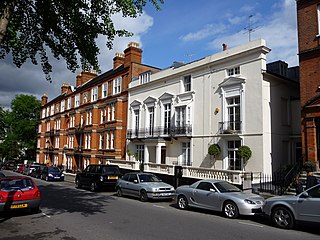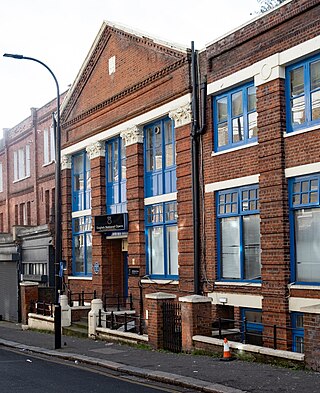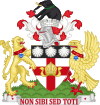
Cricklewood is an area of London, England, which spans the boundaries of the London Borough of Barnet to the east, and the London Borough of Brent to the west. The Crown pub, now the Clayton Crown Hotel, is a local landmark and lies 5 miles (8 km) north-west of Charing Cross.

Hampstead is an area in London, England, which lies four miles northwest of Charing Cross, and extends from the A5 road to Hampstead Heath, a large, hilly expanse of parkland. The area forms the northwest part of the London Borough of Camden, a borough in Inner London which for the purposes of the London Plan is designated as part of Central London.

Kentish Town is an area of northwest London, England in the London Borough of Camden, immediately north of Camden Town. Less than four miles north of central London, Kentish Town has good transport connections and is situated close to the open spaces of Hampstead Heath.

Kilburn is a locality on the boundary of three London Boroughs: Camden, Brent and the City of Westminster. Kilburn High Road railway station lies 3.5 miles (5.6 km) north-west of Charing Cross.

Tufnell Park is an area in north London, England, in the London boroughs of Islington and Camden.

The North London line (NLL) is a railway line which passes through the inner suburbs of west, north-west, north, and north-east London, England between Richmond in the south-west and Stratford in the east, avoiding central London. Its route is a rough semicircle.

West Hampstead is a London Underground station in West Hampstead. It is located on West End Lane between Broadhurst Gardens and Blackburn Road and is situated in Travelcard Zone 2. It is on the Jubilee line between Kilburn and Finchley Road stations. It is 100 m (110 yd) from West Hampstead station on the London Overground North London line and 200 m (220 yd) from West Hampstead Thameslink station. Metropolitan line trains also pass through the station, but do not stop.

Brondesbury is on the North London line, on a viaduct crossing Kilburn High Road in the Brondesbury area of Kilburn in the London Borough of Brent in north-west London.

Gospel Oak is an inner urban area of north west London in the London Borough of Camden at the very south of Hampstead Heath. The neighbourhood is positioned between Hampstead to the north-west, Dartmouth Park to the north-east, Kentish Town to the south-east, and Belsize Park to the south-west. Gospel Oak lies across the NW5 and NW3 postcodes and is served by Gospel Oak station on the London Overground. The North London Suburb, Gospel Oak, has many schools around it.

Swiss Cottage is an area of Hampstead in the London Borough of Camden, England. It is centred on the junction of Avenue Road and Finchley Road and includes Swiss Cottage tube station. Swiss Cottage lies 3.25 miles (5.23 km) north-northwest of Charing Cross. The area was named after a public house in the centre of it, known as "Ye Olde Swiss Cottage".
West Hampstead is an area in north-west London, England that is served by a number of different stations, all of which have very similar names. Although physically separate, they are near each other and the stations form a railway interchange. Two of the stations are part of the National Rail network and the third is on the London Underground.

Belsize Park is an affluent residential area of Hampstead in the London Borough of Camden, England.

South Hampstead railway station is on Loudoun Road in the London Borough of Camden. It is served by London Overground services on the Watford DC line. It is about 550 yards (500 m) south west of Swiss Cottage Underground station.
South Hampstead is an affluent part of the London Borough of Camden in inner north London. It is commonly defined as the area between West End Lane in the west, the Chiltern Main Line (south), Broadhurst Gardens north and north-west followed by a non-road line demarcating the south slopes of Hampstead village, west of Belsize Park, and north and west of the usually narrowly defined Swiss Cottage neighbourhood. It takes in some of Fitzjohns Avenue leading up to "the village", but the exact amount is an arbitrary measure. The streets were laid out in the Victorian era. The area was not served by any railways until Loudoun Road station opened in 1879 on the street of that name.

Decca Studios was a recording facility at 165 Broadhurst Gardens, West Hampstead, North London, England, controlled by Decca Records from 1937 to 1980.

West Hampstead railway station is a London Overground station on the North London Line between Brondesbury and Finchley Road & Frognal in the London Borough of Camden and is in Travelcard Zone 2.

The London Borough of Camden is a London borough in Inner London, England. Camden Town Hall, on Euston Road, lies 1.4 mi (2.3 km) north of Charing Cross. The borough was established on 1 April 1965 and includes the former Central London borough of Holborn, and St Pancras and Hampstead.

Klooks Kleek was a jazz and rhythm 'n’ blues club on the first floor of the Railway Hotel, West Hampstead, north-west London. Named after "Klook's Clique", a 1956 album by jazz drummer Kenny Clarke, the club opened on 11 January 1961 with special guest Don Rendell and closed nine years later on 28 January 1970 after a session by drummer Keef Hartley’s group.

Old Oak Common Lane railway station is a proposed railway station in West London, UK. If constructed, it will be situated on the North London Line, between Acton Central and Willesden Junction, within the London Overground commuter rail system. Old Oak Common Lane station would be situated about 400 yards to the west of the planned Old Oak Common railway station and will offer interchange between London Overground and other rail services, including National Rail, Crossrail and High Speed 2. It is one of two proposed new stations which will connect with Old Oak Common, the other being Hythe Road on the West London line.

Broadhurst Gardens is a street in the London Borough of Camden running eastwards from West End Lane in West Hampstead and ending near to the Finchley Road. It forms the northern border of South Hampstead, and runs parallel to the Midland Main Line. It meets or is crossed by Priory Road, Fairhazel Gardens and Canfield Gardens.



























